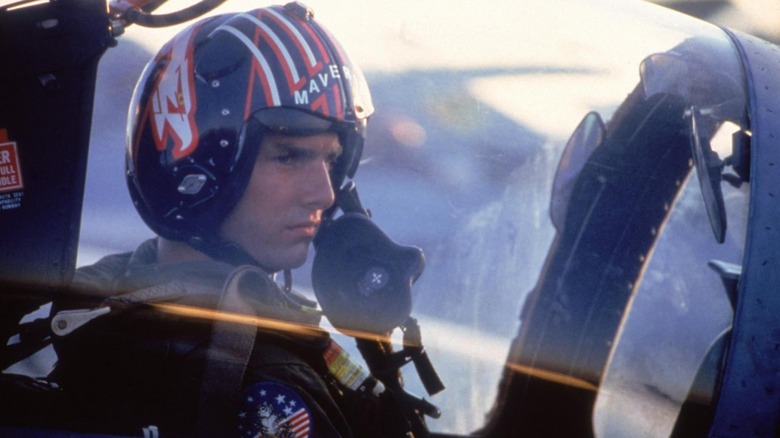Tony Scott Needed A New Perspective To Capture Top Gun’s Breakneck Speeds

"Top Gun" arrived in theaters in May of 1986 with a sonic boom, offering audiences a scintillating and breathtaking look at likfe as a fighter pilot. One of the things that inspired the movie was the aerial photography discussed in a California Magazine article about the Navy's Top Gun fighter pilot training program. According to American Cinematographer, the article and photography caught the eyes of producers Don Simpson and Jerry Bruckheimer. Not long after reading the article, the duo sold the concept to Paramount Pictures.
Before filming could begin, they had to get the approval of the U.S. Navy. Realism was of the utmost importance to the Navy, and that included the visuals. The movie was filmed on actual aircraft carriers and used Navy F-14 Tomcats and F-5 Tigers for the air sequences. Finally, minimal special effects were used.
The final piece of the puzzle was a production crew that could accomplish the verisimilitude that the U.S. military was demanding. Director Tony Scott and cinematographer Jeffrey Kimball were hired to bring the Top Gun program to life. But in addition to the pair, the production team had its own production maverick, an ace up its sleeve in aerial cameraman David Nowell.
How Scott Took Audiences Into The Danger Zone

"Top Gun" offered film audiences an entirely new vision of flight in the movies. Scott and his team took to the skies, putting us inside the cockpits with the pilots and outside with the fighter jets in flanking formations, complex training simulations, and intense dog fights. The cinematography makes viewers feel like an aerial voyeur of the action.
A review in The Hollywood Reporter offered this description of the film's action:
"Undeniably the star of this sizzling production, however, is the technical credits and the direction of Tony Scott. Dog-fighting segments are strictly edge-of-the-seaters ... the high-flying fight choreography is sensational, and director Scott's shrewd use of subjective shots literally puts one in the cockpit."
According to the book "Contemporary Cinematographers on Their Art" Scott used camera mounts on the jets specifically created for the film to capture different angles of the pilots and navigators. Additional cameras were used to capture exteriors of the jets as they burned through the sky to the tune of Kenny Loggins' "Danger Zone."
But Scott wasn't done there. He also relied on an up-and-coming camera operator to capture jaw-dropping aerial scenes without ever leaving the ground.
They Took Aerial Photography To New Heights, Literally

David Nowell is one of more than two dozen credited camera operators in "Top Gun," but his contributions are immeasurable. He initially provided aerial photography for the film, and then Scott asked him to get involved with the ground shoots also. Well, higher ground anyway.
Nowell and his crew used a novel approach to ground photography in the film. They took long lens cameras to the top of a mountain in Nevada, where they were at the same altitude as the fighter Jets. The combination of the height and the long lenses created a look that almost defied logic as if the camera operators were right there in the sky with Maverick and Goose. When Scott combined these shots with the cameras mounted on the jets, it created a look never seen in cinema.
The ground coverage provided a signature look Nowell used in future films including "Iron Eagle 2" and "Outbreak." Nowell said of his signature style:
"You just can't get the high dynamic feel of speed or maneuverability of an aircraft when you're flying with it at the same speed and direction. But fix that camera position and you can really see and feel all this, especially through the look of a long lens."
Nowell explained how director Tony Scott envisioned the dog fights in the film to look like a fight sequence right out of a "Rocky" movie. The combination of edits using three distinct types of shots and a killer soundtrack, "Top Gun" certainly accomplishes that. And while Tom Cruise might have been the big name returning for the film's long-awaited sequel, "Top Gun: Maverick," they also wisely brought back Nowell -- one of the behind-the-scenes stars of the first film -- as the Aerial Director of Photography for the new movie.
Read this next: The 16 Best '80s Action Movies Ranked
The post Tony Scott Needed A New Perspective To Capture Top Gun's Breakneck Speeds appeared first on /Film.
